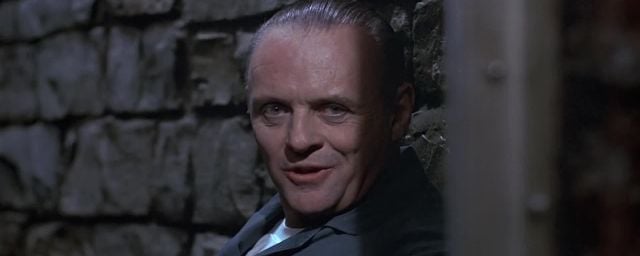His name was Alfredo Ballí Treviño: he was the killer doctor who inspired the character of Hannibal Lecter and Anthony Hopkins when the time came to play him…
Few fictional characters elicit such a visceral reaction as Dr. Hannibal Lecter, the sadistic psychiatrist who first appeared in Thomas Harris’s 1981 novel, Dragon rougewith his penetrating questions, his impeccable manners and his taste for human flesh.
The character is so captivating that he appears in numerous books, films and television series. But it was his portrayal by a grisly Anthony Hopkins in 1991’s The Silence of the Lambs that made him the number one villain of all time by the American Film Institute in 2003.
But if he is already frightening both in writing and on screen, he is even more disturbing… in real life! Because yes, the character is half based on a person who actually existed. His name: Alfredo Ballí Treviño.
A meeting in prison that changed everything
As he revealed in the preface to the novel’s 25th anniversary edition The Silence of the Lambs and 2013 (via Biography.com), Thomas Harris was a 23-year-old journalist in the early 1960s when he visited Nuevo León State Prison in Monterrey, Mexico, to report on an American convicted of murder named Dykes Askew Simmons. The latter, with his disfigured appearance, certainly fit the profile of a killer, but Harris found himself more intrigued by the doctor who had treated the American after a failed prison escape.
Harris met “Dr. Salazar” in the prison medical office, describing him as a “lithe little man with dark red hair” with “a certain elegance”. And what fascinated him: his probing questions when he began to interrogate him to find out his opinion on Simmons’ disfigured appearance.
“Were the murdered people attractive?” Salazar demands. “Oui”, replied Harris. Was the doctor insinuating that the beautiful victims had driven Simmons into a violent rage?
“Certainly not”, replied the doctor. “But early torment makes torment easily… imaginable.”
“You are a journalist, Mr. Harris”, continues-t-il. “CHow would you put this in your journal? How do you deal with the fear of torment in journalistic jargon? Could you say something scathing about torment, like ‘it’s the hell of hello’? [‘It puts the hell in hello’, jeu de mots, NDLR].”
Later that day, Harris was surprised to learn that Dr. Salazar was not a prison employee, as he assumed, but a convict facing a long stay behind bars. “The doctor is a murderer”, the director told him. “As a surgeon, he could pack his victim into a surprisingly small box. He will never leave this place. He’s crazy.”

Orion Pictures
According to the British Times and the Latin Times, the “Salazar” of Harris’ story was known by the real name Alfredo Ballí Treviño. He was born into a prominent family in Méndez, Tamaulipas state. His strict father pushed the boy and his siblings to excel in their studies.
In 1959, while a medical intern, Ballí Treviño had an argument with his lover, Jesús Castillo Rangel, either because of money problems or because he wanted to marry a woman. The future doctor then killed her boyfriend, carefully cut him into pieces to fit into a box, and attempted to bury the box on a ranch.
But his work was quickly discovered and Ballí Treviño was sentenced to death in 1961 for his “crime of passion”. He was also allegedly suspected of killing and dismembering hitchhikers, although these accusations were apparently never proven.
During his time in prison, the “Werewolf of Nuevo León,” as he was nicknamed, reportedly continued to dress in light suits, dark sunglasses, and wearing his gold Rolex watch. He also maintained an informal medical practice treating other prisoners and visiting townspeople.

Orion Pictures
His sentence reduced after 20 years behind bars, Ballí Treviño returned to his old neighborhood in Monterrey to treat the sick and poor, often for free. He agreed to give a newspaper interview in 2008, months before his death from prostate cancer, but refused to talk about his violent past, saying: “I don’t want to wake up my ghosts.”
Other sources of inspiration
Before Harris spoke about his fateful visit to the Mexican prison, theories abounded as to what inspired the writer to create such a powerful character.
In a 1999 article in Tulsa World, a group of detectives familiar with Harris suggested that Lecter was a mix of the highly intelligent serial killers Ted Bundy and Edmund Kemper, with a bit of the cannibal Issei Sagawa. That same article also mentioned another cannibalistic killer from an earlier generation named William Coyner, a bogeyman well known to Harris and his friends in Mississippi in the 1940s and 1950s.
In his preface to Silence of the Lambs, Thomas Harris confirmed that Lecter was not entirely based on Ballí Treviño, but he left no doubt about the Mexican doctor’s lasting influence on the character as the infamous villain of his novels took shape in his mind.
“My detective needed to speak to someone who had a special understanding of the criminal mind”, he wrote. “Lost in the work tunnel, I trudged behind my detective when he went to the Baltimore State Hospital for the Criminally Insane to consult with an inmate. Who do you think was waiting in the cell? It wasn’t Dr. Salazar”, continued Harris. “But thanks to Dr. Salazar, I was able to recognize his colleague and fellow practitioner, Hannibal Lecter.”
The Silence of the Lambs can be found on VOD.


